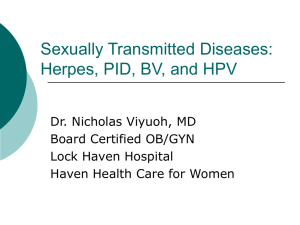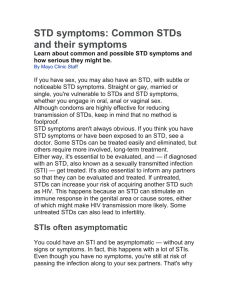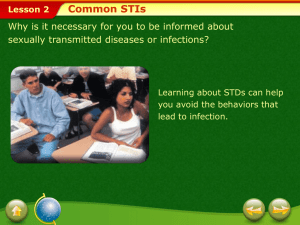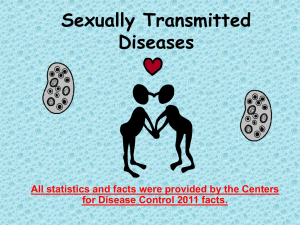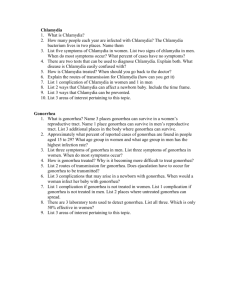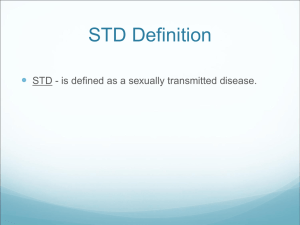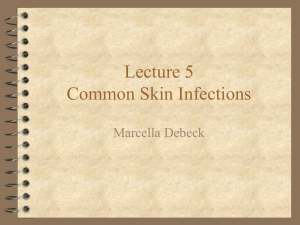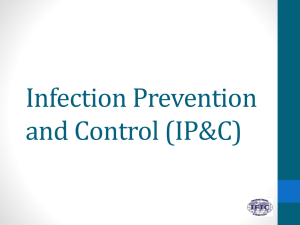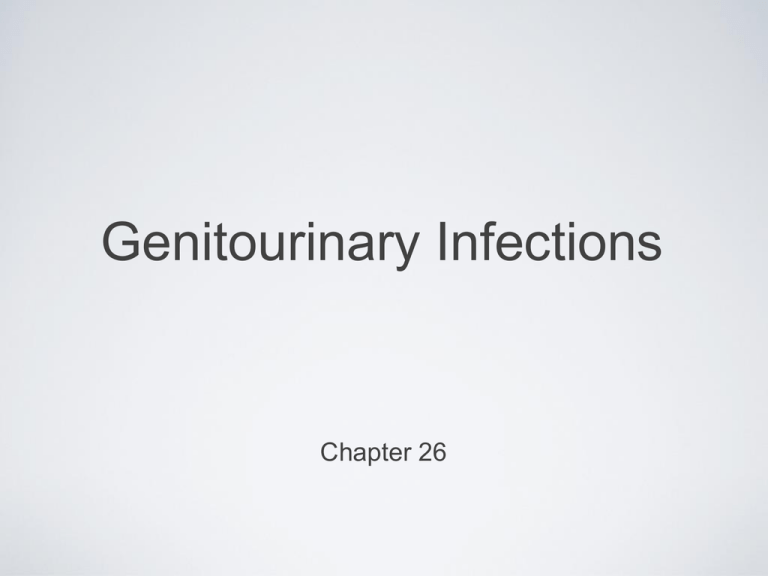
Genitourinary Infections
Chapter 26
Genitourinary Infections
• Infections of reproductive and urinary system are
common
• Urinary infections most common
• United States leads industrialized nations in
reported incidence of sexually transmitted
infections (STI)
Normal Flora of
Genitourinary System
• Normally urine and urinary tract above bladder entrance
free of microorganisms
– Lower urethra contains normal resident flora
• Species include Lactobacillus, Staphylococcus,
Corynebacterium and Streptococcus
• Normal flora and resistance to infection varies in female
genital tract
– Depends considerably on hormonal status
Urinary System Infections
• Urinary tract infections (UTI)
account for around 7 million
doctor visits annually in United
States
– May include any or all of the
organs of the urinary system
– Any situation interfering with
urine flow increases risk of
infection
Vulvovaginal Cadidiasis
• Symptoms
– Most common
symptoms include
• Itching
• Burning
• Scant vaginal discharge
– White in curd-like
clumps
• Involved area usually
red and swollen
•Causative Agent
–Candida albicans
•Part of normal flora in
approximately 35% of women
Vulvovaginal Cadidiasis
• Pathogenesis
– Normally causes no symptoms
• Due to balance between organism and normal vaginal flora
– When balance upset fungi multiply without restraint
• Cause inflammatory response and symptoms
• Epidemiology
– Disease not spread person to person
• Generally not sexually transmitted
– Antibacterial medications increases risk of disease
• Increases duration of treatment (kills normal flora bacteria)
Vulvovaginal Cadidiasis
• Prevention and Treatment
– Prevention directed at minimizing use and duration of
antibiotic therapy
– Intravaginal treatment with antifungal medication usually
effective
• Nystatin and clotrimazole most effective
• Fluconazole given by mouth usually effective
– 1 out of 7 suffer side effects
Staphylococcal Toxic Shock
• Symptoms
– Characterized sudden onset of symptoms including
• Headache
• High temperature
• Muscle aches
• Blood shot eyes
• Vomiting
• Diarrhea
• Sunburn like rash
• Confusion
– Without treatment symptoms also include
• Dropping blood pressure
• Kidney failure
• Death
•
STAPHYLOCOCCAL TOXIC
Causative Agent SHOCK
– Staphylococcus aureus
• Produces one or more exotoxins
– All act as super antigens
• Toxic shock syndrome toxin-1 (TSST-1) accounts for nearly 75%
of cases
– Remaining 25% due to other staphylococcal exotoxins
• Pathogenesis
– Disease results from toxin absorption into bloodstream
• Vaginal abrasion probably aids in absorption
– Toxins cause massive release of cytokines
• Cytokines cause drop in blood pressure and kidney failure
STAPHYLOCOCCAL TOXIC
SHOCK
• Epidemiology
– Can occur after
infection with toxinproducing
Staphylococcus
aureus
– Does not spread
person-to-person
– Can occur after
infected surgical
wounds
–Use of tampons increases
risk
•Higher absorbency increase risk
•Most menstruating associated
cases are women under 30
•
STAPHYLOCOCCAL TOXIC
Epidemiology
SHOCK
– Recovery does not consistently infer immunity
• 30% will suffer relapse
– Relapse usually milder
– There is a slow steady decline in incidence
• Incidence estimated 2/100,00 menstruating women
per year
• Prevalence of non-menstruating toxic shock
increasing
STAPHYLOCOCCAL TOXIC
SHOCK
• Prevention and Treatment
– Decline in incidence credited to better understanding of
tampon use
– Withdrawing from use of higher absorbency tampons
– Tampon-associated infection can be minimized by
• Washing hands
• Using lowest absorbency practical
• Change tampon every 6 hours
– Wear pad to bed
• Avoid trauma when inserting
• Know and understand symptoms
• Don’t use tampons if recovered from TSS
STAPHYLOCOCCAL TOXIC
SHOCK
• Prevention and Treatment
– TSS can be treated with anti-staphylococcal medications,
intravenous fluid
– Prevention measures should be taken to prevent shock
and kidney damage
– Most recover in 2 to 3 weeks
• Mortality rate is approximately 3%
Gonorrhea
• Symptoms
– Incubation period 2 to 5 days post exposure
– Asymptomatic infection can occur on both sexes
– In men symptoms characterized as urethritis with
• Pain on urination
• Discharge from penis
– In women symptoms are
• Painful urination
• Mild discharge
– May be overlooked
– Women more likely to be asymptomatic carriers
GONORRHEA
• Causative Agent
– Neisseria gonorrhoeae
• Gram negative
• Diplococcus
• Typically found on or in leukocytes in urethral pus
• Infect only humans
• Most strains do not survive well outside host
• Transmitted primarily by intimate sexual contact
• Increasing number of strains resistant to antibiotics
GONORRHEA
• Pathogenesis
– Attach to non-ciliated epithelial cells via pili
• Particularly of the urethra, uterine cervix and conjunctiva
• Bacterial proteins bind CD4 lymphocytes
– Prevents activation of immune response
– Antigenic variation allows escape from antibody
• Variation interferes with ability to make effective vaccine
– Untreated disease in men can lead to complications
including
• Urinary tract infections
• Orchitis
• Sterility
GONORRHEA
• Pathogenesis
– In women disease follows different course
• Organism thrives in cervix and fallopian tubes
– 15% to 30% of untreated women develop pelvic
inflammatory disease (PID)
– Scar tissue formation in fallopian tubes lead to
increased risk of ectopic pregnancy and sterility
– Opthalmia neonatorum
• Gonococcal conjunctivitis of the newborn
– Acquired from infected birth canal
– Prevented with silver nitrate or erythromycin within
1 hour of birth
GONORRHEA
• Epidemiology
– Second most prevalent STI
• Only after Chlamydia
– Factors that influence infection include
• Birth control pills
– May increase susceptibility to infection (causality)
– More often engage in sex without condom (correlation)
• Carriers
– Those with asymptomatic infection
• Lack of immunity
– No immunity following recovery
GONORRHEA
• Prevention and Treatment
– Prevention directed at
• Abstinence
• Monogamous relationship
• Constant use of condom
– No vaccine available
– Fluoroquinolones and cephalosporins effective against
95% of strains
Chlamydial Genital
System Infections
• Symptoms
– Generally appear in 7 to 14 days
– In men
• Thin grayish-white discharge from penis
• Sometimes painful testes
– In women
• Increased vaginal discharge
• Often painful urination
• Abdominal bleeding
• Upper and lower abdominal pain
• Women often asymptomatic
Chlamydial Genital
System Infections
• Causative Agent
– Chlamydia trachomatis
• Spherical
• Obligate intracellular
bacterium
• Form inclusion bodies
inside infected cells
– Used for rapid
identification
• Approximately eight types
responsible for STI
Chlamydial Genital
System Infections
• Pathogenesis
– Infectious form attaches to
host epithelial cells
• This form called elementary
body
• Cells take up organism
through endocytosis
– Bacterial enlarges in
vacuole
• Becomes non-infectious
– Form called reticular body
– Reticular body divides
repeatedly
• Produces numerous
elementary bodies
– These infect nearby cells
–Much tissue damage results from
cellular immune response
–In men
Infection spreads from urethra to
tubules
Results in acute swelling
–In women
Infection commonly involves cervix,
uterus and fallopian tubes
Resulting in pelvic inflammatory
disease, ectopic pregnancy or
sterility
Chlamydial Genital
System Infections
• Epidemiology
– Reportable infectious disease
• Number of reported cases tend to rise each year
– Estimated 4 million reported in United States
– According to study 14% of sexually active high school
and college women are asymptomatic carriers
– Non-sexual transmission also occurs
• Major source is non-chlorinated swimming pools
– Newborns contract conjunctivitis much like with
gonorrhea
Chlamydial Genital
System Infections
• Prevention and Treatment
– Abstinence
– Monogamous relationship
– Use of condom
– All sexually active women should get tested annually
• Semi annually if multiple partners
– Azithromycin effective single dose treatment
– Tetracycline and erythromycin less expensive
alternatives
Genital Herpes
• Symptoms
– Begin 2 to 20 days post infection
– Genital itching and burning
– Pain
• Primarily in women
– Blisters develop on genitals
– Blisters heal spontaneously
• Most patients will have recurrence
• Causative Agent
– Usually herpes-simplex virus type 2
– DNA virus
– Disease recurrence due to latent virus
Genital Herpes
• Pathogenesis
– Blisters created by infected epithelial cells
• Blisters contain large numbers of bacteria
– Blisters rupture to produce painful ulcerations
– Latency follows ulceration
• Viral DNA exists in cell in non-infectious form within nerve cell
– Recurrence is due to replication of complete virions from
latent DNA
• Viruses re-infect area supplied by nerve
– Congenital herpes can pose serious risk for newborn
• 1 in 3 newborns contract herpes if mother has primary infection
at time of birth
• Can be debilitating and potentially lethal
GENITAL HERPES
• Epidemiology
– No animal reservoir
– Virus can survive short time on fomites or in bathwater
• Non-sexual transmission rarely occurs
– Sexual transmission most likely occurs during first days
of symptomatic disease
• Transmission can occur in absence of symptoms
– Once infected there is lifelong risk of transmission
GENITAL HERPES
• Prevention and Treatment
– Avoidance of sexual intercourse during active symptoms
• Use of condom and spermicide reduce but do not
eliminate transmission
– There is no cure for genital herpes
• Medications such as acyclovir and famciclovir can
decrease severity
PapillomavirusES - Genital Warts and
Cervical Cancer
• Symptoms
– Individual may be asymptomatic
• Especially women
– Genital warts most easily recognized symptom
• Often appear on the head or shaft of penis, at the vaginal
opening or around anus
– Warts can become inflamed or bleed
– Precancerous lesion on cervix often asymptomatic
• Can be detected with vaginal exam (pap smear)
PapillomavirusES - Genital Warts and
Cervical Cancer
• Causative agent
– Human papillomavirus
(HPV)
•Pathogenesis
HPV enters and infects deeper layers of
tissue through abrasions
May lead to latent infection
– Non-enveloped, double
stranded DNA virus
• Nearly 100 types of HPV
– 30 are transmitted
sexually
– 15 type strongly
associated with cancer
» 4 account for most
cases in U.S.
Mechanism of wart formation is unknown
Warts usually appear about 3 months after
infection
Removal of warts does not eliminate virus
HPV can be transmitted to fetus through
birth canal
Most cervical cancers associated with HPV
PapillomavirusES - Genital Warts and
Cervical Cancer
• Epidemiology
– HPV readily spread through
sexual contact
• Asymptomatic carriers can infect
others with HPV
– HPV most common reason for
abnormal pap smear
– History of multiple sex partners is
most important risk factor for
acquiring HPV
– Warts can develop in the mouth
via oral sex
PapillomavirusES - Genital Warts and
Cervical Cancer
• Prevention and Treatment
– Condom use can help decrease chance of transmission
– Women should have pap smear annually
• Can identify precancerous lesions
• Abnormal growth can be removed preventing
development of cancer
– Warts can be removed by laser treatment or freezing
with liquid nitrogen
– Gardasil vaccine - covers four most common viruses in
U. S.

